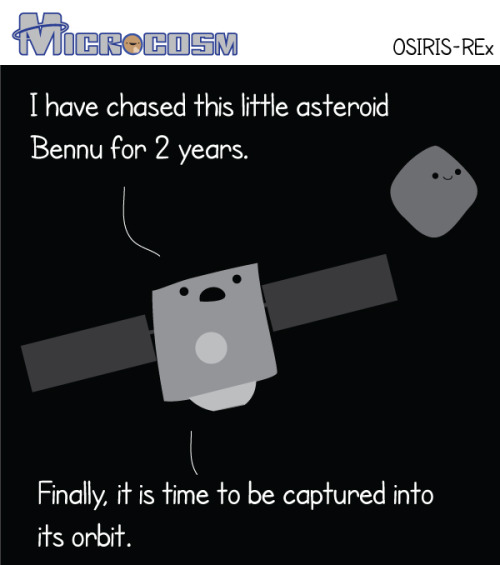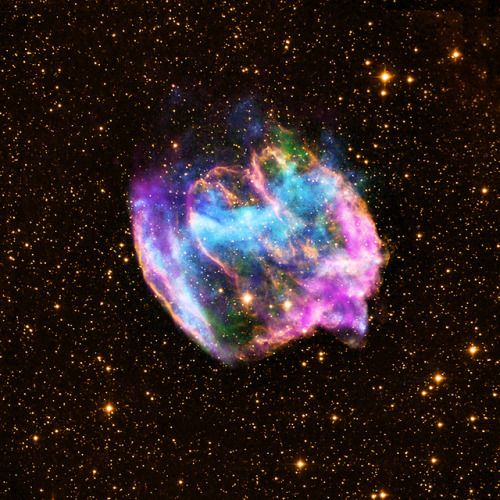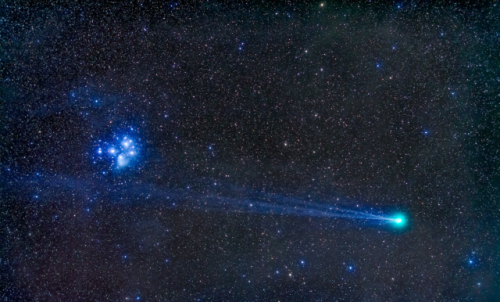Brown Dwarfs, Or “Failing Stars”, In The Orion Nebula. Image Credit: NASA, ESA, M. Robberto (Space

Brown Dwarfs, or “Failing Stars”, in the Orion Nebula. Image credit: NASA, ESA, M. Robberto (Space Telescope Science Institute/ESA) and the Hubble Space Telescope Orion Treasury Project Team [3939x2955]
More Posts from Astrosciencechick and Others

The Orion Bullets via NASA https://ift.tt/2VwwqDm

Chandra/Hubble/Spitzer X-Ray/Visible/Infrared Image of M82.
Credit: NASA, ESA, CXC and JPL-Caltech

Nancy Grace Roman: NASA’s First Chief Astronomer via NASA https://ift.tt/2HmRxo3




OSIRIS-REx arrived at asteroid Bennu this week! It will stay in orbit to do a complete survey of the asteroid. But even cooler, it will get so close to the surface it will touch Bennu briefly and use a puff of hydrogen to dislodge surface material, that it will then collect. After that, OSIRIS-REx heads back to Earth to deliver the sample!
Here is a really cool video on how this little orbiter got to Bennu and detailing its mission.
https://youtu.be/NYGHbl_esgw

NGC 6960: The Witchs Broom Nebula : Ten thousand years ago, before the dawn of recorded human history, a new light would have suddenly have appeared in the night sky and faded after a few weeks. Today we know this light was from a supernova, or exploding star, and record the expanding debris cloud as the Veil Nebula, a supernova remnant. This sharp telescopic view is centered on a western segment of the Veil Nebula cataloged as NGC 6960 but less formally known as the Witch’s Broom Nebula. Blasted out in the cataclysmic explosion, the interstellar shock wave plows through space sweeping up and exciting interstellar material. Imaged with narrow band filters, the glowing filaments are like long ripples in a sheet seen almost edge on, remarkably well separated into atomic hydrogen (red) and oxygen (blue-green) gas. The complete supernova remnant lies about 1400 light-years away towards the constellation Cygnus. This Witch’s Broom actually spans about 35 light-years. The bright star in the frame is 52 Cygni, visible with the unaided eye from a dark location but unrelated to the ancient supernova remnant. via NASA

I want to be taking notes.
(via Hometalk)
![[OC] Nine Merlin Engines Bloom At High Altitude As SpaceX Falcon9 Streaks Across The Night Sky](https://64.media.tumblr.com/b7bddab3aef6ca44a36cada355f147b8/tumblr_ppg9adDtPx1rcl722o1_500.jpg)
[OC] Nine Merlin engines bloom at high altitude as SpaceX Falcon9 streaks across the night sky

The highly distorted supernova remnant shown in this image may contain the most recent black hole formed in the Milky Way galaxy. The image combines X-rays from NASA’s Chandra X-ray Observatory in blue and green, radio data from the NSF’s Very Large Array in pink, and infrared data from Caltech’s Palomar Observatory in yellow.
Credits: X-ray: NASA/CXC/MIT/L.Lopez et al; Infrared: Palomar; Radio: NSF/NRAO/VLA

NGC 3372, Dusty Carina

Comet Lovejoy and The Pleiades
-
 shannybangbang reblogged this · 5 months ago
shannybangbang reblogged this · 5 months ago -
 adelheidthedoll reblogged this · 2 years ago
adelheidthedoll reblogged this · 2 years ago -
 nystroa liked this · 4 years ago
nystroa liked this · 4 years ago -
 8ug8ear reblogged this · 4 years ago
8ug8ear reblogged this · 4 years ago -
 8ug8ear liked this · 4 years ago
8ug8ear liked this · 4 years ago -
 arahati reblogged this · 4 years ago
arahati reblogged this · 4 years ago -
 softtbambi liked this · 4 years ago
softtbambi liked this · 4 years ago -
 numerical-soup reblogged this · 4 years ago
numerical-soup reblogged this · 4 years ago -
 sylvia-trash reblogged this · 4 years ago
sylvia-trash reblogged this · 4 years ago -
 camimillion reblogged this · 4 years ago
camimillion reblogged this · 4 years ago -
 bugpov reblogged this · 4 years ago
bugpov reblogged this · 4 years ago -
 evilforces reblogged this · 4 years ago
evilforces reblogged this · 4 years ago -
 wolverine-teeth reblogged this · 4 years ago
wolverine-teeth reblogged this · 4 years ago -
 scentlessapprenticeship liked this · 4 years ago
scentlessapprenticeship liked this · 4 years ago -
 aprilphantom reblogged this · 4 years ago
aprilphantom reblogged this · 4 years ago -
 thundermask liked this · 5 years ago
thundermask liked this · 5 years ago -
 silenus-x reblogged this · 5 years ago
silenus-x reblogged this · 5 years ago -
 a-god-in-ruins-rises reblogged this · 5 years ago
a-god-in-ruins-rises reblogged this · 5 years ago -
 insomniacafe98 reblogged this · 5 years ago
insomniacafe98 reblogged this · 5 years ago -
 insomniacafe98 liked this · 5 years ago
insomniacafe98 liked this · 5 years ago -
 nadicaaaaaa reblogged this · 5 years ago
nadicaaaaaa reblogged this · 5 years ago -
 purmoved reblogged this · 5 years ago
purmoved reblogged this · 5 years ago -
 opium-bunny reblogged this · 5 years ago
opium-bunny reblogged this · 5 years ago -
 cadanube reblogged this · 5 years ago
cadanube reblogged this · 5 years ago -
 m0shpotatos reblogged this · 5 years ago
m0shpotatos reblogged this · 5 years ago -
 every-time-i-rise reblogged this · 5 years ago
every-time-i-rise reblogged this · 5 years ago -
 ssoftluv liked this · 5 years ago
ssoftluv liked this · 5 years ago -
 ferrret reblogged this · 5 years ago
ferrret reblogged this · 5 years ago -
 ferrret liked this · 5 years ago
ferrret liked this · 5 years ago -
 staravia reblogged this · 5 years ago
staravia reblogged this · 5 years ago -
 maidencryptid reblogged this · 5 years ago
maidencryptid reblogged this · 5 years ago -
 maidencryptid liked this · 5 years ago
maidencryptid liked this · 5 years ago -
 imjustlikeyoubutworse reblogged this · 5 years ago
imjustlikeyoubutworse reblogged this · 5 years ago -
 alfanatix liked this · 5 years ago
alfanatix liked this · 5 years ago -
 crossedtears reblogged this · 5 years ago
crossedtears reblogged this · 5 years ago -
 borstal reblogged this · 5 years ago
borstal reblogged this · 5 years ago -
 danraptor reblogged this · 5 years ago
danraptor reblogged this · 5 years ago -
 danraptor liked this · 5 years ago
danraptor liked this · 5 years ago